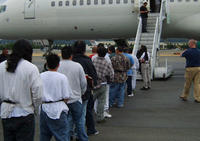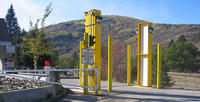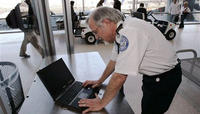-
Mexican cartels' assassins operate in Arizona
Drug smuggling gangs in Mexico have sent well-armed assassins, or sicarios, into Arizona to locate and kill bandits who are ambushing and stealing loads of cocaine, marijuana, and heroin headed to buyers in the United States; the drug cartels have posted scouts on the high points in the mountains and in the hills surrounding the Vekol Valley smuggling corridor; says the country sheriff: “They have radios, they have optics, they have night-vision goggles as good as anything law enforcement has—- This is going on here in Arizona. This is 70 to 80 miles from the border — 30 miles from the fifth-largest city in the United States”
-
-
FY2010 sees record alien removal from U.S.

In fiscal year 2010 DHS set a record for overall removals of illegal aliens, with more than 392,000 removals nationwide; half of those removed — more than 195,000 — were convicted criminals; the fiscal year 2010 statistics represent increases of more than 23,000 removals overall and 81,000 criminal removals compared to fiscal year 2008 — a more than 70 percent increase in removal of criminal aliens from the Bush administration
-
-
Final phase of TSA's Secure Flight program taking effect
As of 1 November, all domestic airlines will collect passengers’ names, dates of birth, and gender of passengers at the time of booking a flight; international carriers will do the same by the end of the year; passengers who do not enter all information at least seventy-two hours prior to departure will not be able to print out boarding passes
-
-
Mexican mayors: Returning criminal Mexicans to border towns increases violence
A coalition of Mexican mayors say the United States is contributing to the increase in violence in Mexican border towns by busing repatriated Mexicans who committed crimes in the United States to these border towns — where they join the ranks of the drug cartels — rather than drive or fly them back to their home towns
-
-
Italian airport security drop body scanners
After a six-month test, Italy is giving up full-body scanners for security checks in airports; officials said it takes longer to check a person by scanner — about thirty seconds — than by hand, and privacy measures reduced the scanners’ effectiveness
-
-
Feds arrest Arizona buyers of guns for drug cartels
Mexico’s violent drug war — which, in the last four years, has claimed nearly 30,000 dead — is fought with American guns; in a sweeping operation aimed at uncovering “straw buyers” blamed for funneling high-powered guns to Mexican drug cartels, federal agents have arrested dozens of Arizonans and seized a large amount of weapons
-
-
DHS looking for systems to detect drug smugglers' ultralights
Mexican drug cartels have been using ultralights — slow-moving, low-flying aircraft, not much more than a hang glider equipped with an engine — to smuggle drugs into the United States; DHS wants to buy off-the-shelf systems to track these hard-to-detect craft
-
-
GAO: $4 billion border radiation detectors program a bust

The Government Accountability Office (GAO) reported Wednesday that the $4 billion program to install radiation detectors at U.S. border crossings yielded few tangible results; the detection machines were too big for border inspection lanes, and the software for the Cargo Advanced Automated Radiography Systems also was not up to the task; DHS: “We are mindful of getting something delivered that has a credible basis for the implementation plan that follows”
-
-
New report: UAVs for Border Security -- market & technologies outlook 2010-15
The use of UAVs in border security missions around the world is expanding rapidly from very little activity today; this expansion will create new markets and new business opportunities, particularly for integrated capabilities guided by an operating concept and turn-key packages that include equipment, training, operations, and maintenance
-
-
DHS testing iris scan technology at border crossings

DHS is beginning a 2-week trial of iris scanning technology at a Border Patrol station in McAllen, Texas, where they will be used on illegal immigrants; a new generation of cameras that capture images from six feet away instead of a few inches; DHS will test cameras that take photos from 3 or 4 feet away, including one that works on people as they walk by; the ACLU is raising objections, saying the cameras could be used covertly
-
-
U.K. Borders Agency in immigration biometrics deal with IBM
The deal is valued at £191 million, and the government says it will save tax payers £50 million. or nearly 20 percent, from the contract price with IBM by cutting aspects of the planned system that were no longer needed
-
-
Mobile biometric and document device for borders
NEC shows a tablet computing device for biometric identity enrollment and verification using multiple biometrics — and which can also read travel documents; the company says the device will be sold to border control agencies
-
-
U.S.: Mexico's drug war posing growing threat to U.S. national security
The Obama administration sees the drug-related violence sweeping Mexico as a growing threat to U.S. national security and has launched a broad review of steps the military and intelligence community could take to help combat what U.S. officials describe as a “narcoinsurgency”; one problem with increased intelligence collaboration: U.S. agencies have been wary of sharing some intelligence because of concerns that some of their Mexican counterparts may be on the payroll of the cartels
-
-
Repeal of birthright citizenship would swell ranks of U.S. unauthorized population

Passage of the House-introduced Birthright Citizenship Act, which would deny U.S. citizenship to children born to parents who are both unauthorized immigrants, would increase the unauthorized population from its current 10.8 million to 16 million by 2050; if U.S. citizenship is denied to children who have one unauthorized immigrant parent, the total unauthorized population would rise to 24 million in 2050 under a scenario in which citizenship is denied to U.S.-born children who have one unauthorized immigrant parent, even if the other parent were a U.S. citizen; under a scenario of denying birthright citizenship to children who have at least one authorized immigrant parent, by the third generation, 6.3 million U.S.-born people would be unauthorized despite having two U.S-born parents
-
-
New legal challenge to DHS laptop searches at U.S. border

The Obama administration has continued a Bush administration policy which permits officers at U.S. borders to detain travelers’ laptop computers and examine their contents even without suspecting the traveler of wrongdoing — or, in the language of DHS policy, “absent individualized suspicion”; in a federal lawsuit filed Tuesday in the Eastern District of New York, the plaintiffs allege that DHS policy of substituting “search at will” for “reasonable suspicion” violates constitutional rights to privacy and free speech
-
- All
- Regional
- Water
- Biometrics
- Borders/Immig
- Business
- Cybersecurity
- Detection
- Disasters
- Government
- Infrastructure
- International
- Public health
- Public Safety
- Communication interoperabillity
- Emergency services
- Emergency medical services
- Fire
- First response
- IEDs
- Law Enforcement
- Law Enforcement Technology
- Military technology
- Nonlethal weapons
- Nuclear weapons
- Personal protection equipment
- Police
- Notification /alert systems
- Situational awareness
- Weapons systems
- Sci-Tech
- Sector Reports
- Surveillance
- Transportation
Advertising & Marketing: advertise@newswirepubs.com
Editorial: editor@newswirepubs.com
General: info@newswirepubs.com
2010-2011 © News Wire Publications, LLC News Wire Publications, LLC
220 Old Country Road | Suite 200 | Mineola | New York | 11501
Permissions and Policies
Editorial: editor@newswirepubs.com
General: info@newswirepubs.com
2010-2011 © News Wire Publications, LLC News Wire Publications, LLC
220 Old Country Road | Suite 200 | Mineola | New York | 11501
Permissions and Policies
